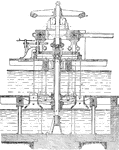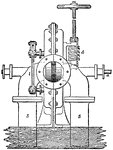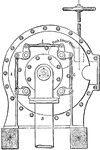Clipart tagged: ‘Hydromechanics’

Capillary Attraction
"b is a glass tube in water and c is a glass tube in mercury. The surface of the water in the tube b…

Centrifugal Pump
"A centrifugal pump differing from an ordinary centrifugal pumps in one feature only. The water rises…

Guideblade Chamber
"The sectional form of the guideblade chamber and the wheel and the curves of the wheel vanes and guideblades,…

Guideblade Chamber
"The sectional form of the guideblade chamber and the wheel and the curves of the wheel vanes and guideblades,…

Girard Turbine
"The general sectionl elevation of a Girard turbine, in which the flow is axial. The water, admitted…

Reaction Turbine
"Professor James Thomson's inward flow or vortex turbine has been selected as the type of reaction turbines.…

Reaction Turbine
"Professor James Thomson's inward flow or vortex turbine has been selected as the type of reaction turbines.…

Reaction Turbine
"Professor James Thomson's inward flow or vortex turbine has been selected as the type of reaction turbines.…

Reaction Turbine
"Professor James Thomson's inward flow or vortex turbine has been selected as the type of reaction turbines.…

Water Wheel
"When a water fall ranges between 10 and 70 feet, and the water supply is from 3 to 25 cubic feet per…